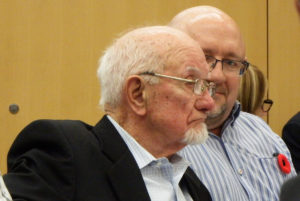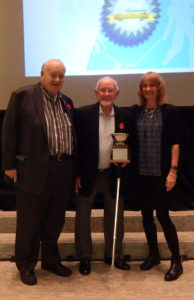

Galt native Herb Morton was born to Irish immigrants Joseph and Catherine in the old Galt Hospital during the Great Depression, and grew up not too far away.
He was part of a large family (seven children), and although most of his siblings were born in Canada, two older brothers were born in Ireland.
He began his lifelong affiliation with sport as a kid playing tibbi, a sport — a cross between cricket and baseball — unique to the south Waterloo area. “I played tibbi for hours at a time,” he said, at places like St. Andrew’s School. “Two pieces of broom handle, and a piece cut off the end with tape on it — that was the tibbi, and we had two holes in the ground. We played that for hours and hours and hours.”
The sport has now almost faded from living memory except for oldtimers like Morton. “They don’t play it anymore,” laments Morton. “In those days everybody played it.”
For many youngsters, it was the only game in town until they got older, as there was no minor ball then, and organized hockey didn’t begin until bantam or midget.
“When I came out of the Navy in 1955 we were still playing it — Bill Mortimer, Ted Elsby, Squib (Ronny) Collins and me. All the old guys knew about it but the young guys would say, ‘What the hell are you playing?'”
Gradually it just died out.
Morton was a good young athlete. At St. Andrew’s school he enjoyed playing ball – softball and fastball – with the other kids, and one day he saw the principal, Dode Hoffman, and George Rutherford watching the students on the diamond.
“He was a good guy. He was the coach of the Kitchener Panthers.” Intercounty baseball team.”
He was a smart baseball man.”
Paris native George Rutherford, a good friend of Syl Apps’ was a teacher at the school then and later became principal. He and Hoffman were watching the kids play ball and Morton saw the two looking out the second floor window. So Morton turned to a friend and said he was going to put the ball through the window they were looking out.
“I says to Donny Welsh to throw me one high and inside.”
The pitch came and it was perfect. Morton swung and moments later the ball sailed up and yonder, smashing the very window above the boys entrance he said he would.
They used to try to hit them onto the roof and then they’d get the caretaker to retrieve them.
“Dode had me in the office so quickly after that,” said Morton, who had to think quick.
“You did that on purpose,” said Hoffman. “I think you tried to break that window.”
“If I could do that I’d be playing for you with the Kitchener Panthers,” explained Morton. It worked. Hoffman had, after all, admired the hit.
“Get outta here,” he said to Morton.
“I remember the Civic Service Club put on a banquet for the public school city championship that we won, about 1945 or ’46, and George Rutherford brought Syl Apps as the guest speaker.” It was at the Iroquois Hotel on Main Street.
Apps, who spent a lot of time in Galt as a youngster with his grandparents, the Wrigleys, is one of the all-time Toronto Maple Leaf greats and is buried in Galt’s Mount View Cemetery.
Morton vividly recalls where he was on VJ Day (Victory over Japan). “Me and the Sabatines (Carl and Morris) were playing hockey on Cambridge Street and Gordie Howe came out of the factory (Galt Art Metal) and picked up a stick and played with us. We didn’t even know who he was really. Mrs. Sabatine made us hot chocolate, I know that.”
Howe was practicing with the Galt Jr. A Red Wings and playing exhibitions, but couldn’t get his release to play for the Red Wings. He chose to work at Art Metal rather than attend GCI, though it was a decision he came to regret.
Morton enjoyed going to the hockey games at Galt Arena, and can even remember attending Galt Kist Canadiens games prior to the Red Wings taking up residence in Galt.
Bobby Hull came to town to play with the Galt Black Hawks when Morton was in the Navy, but when Morton returned, he remembers eeeing a young Hull and recalled he was the palest guy he ever saw. “He could fly on a pair of skates, but he was the colour of that piece of paper over there,” he said pointing to a white sheet.
Morton recalled with fondness the haunts of his childhood on the west side hills behind the old Galt Hospital. “This is where we built huts, and played, skied and tobaganned. There use to be a gravel pit over there.” It provided hours of fun.
He often played hockey outdooors down near the river on a pond out back of the Culham farm. “Jim Culham only had one hand, but could he play hockey! I played against him in the Industrial league and he played for Newlands.”
Morton quit school in Grade 11 at GCI, then spent two and a half years learning his trade at Sheldons.
Morton joined the Navy in 1950, and circumnavigated the globe on the HMCS Nootka — the first Canadian naval vessel to circumnavigate the earth with the ame crew. The Second World War ship the Uganda did it after WWII when it was recomissioned, but used a different crew for portions.
“We left December 28, and had New Year’s Day in Cuba, then through the Panama Canal, to Mexico, San Diego, Pearl Harbor for gunnery practice, then to the Midway Islands, and then by February 14 we got to Japan. We stayed there for a year.
He also played a lot of softball in the Navy. The Japanese would also play in their leisure time. “Boy could they play,” he said.
“The night we left to come home from Korea me and a petty officer went down to slush up a boiler but a bilge fire started. That fellow died, and they took a couple of us to sick bay. We came home through the Suez Canal.”
It was quite a journey. They saw India, went through the Red Sea to Palestine, then Malta, Gibralter, the Azores and finally home over the North Atlantic, which is normally a rough sea, but was as smooth as glass. We got home three days before Christmas.”
It was after his five year stint in the Navy that Morton got heavily involved in local sports, playing and coaching the Galt Gores Intercity Fastball championship teams of the 1960s. The team was later inducted into the Cambridge Sports Hall of Fame.
He got great satisfaction out of coaching the youngsters. “That’s what it was all about,” he said. “It was just fantastic. It was the kids. We had a lot of class kids playing for us, guys like Bobby Johnson, Kenny Riddell, Jimmy Baird, Mickey Mowbray — all just class kids, and they’re class people now. We never had to hollar at them, they always showed up for practice. There were a lot of smart ballplayers, the likes of Jim Baird and all those guys, and they just knew how to play ball.”
When he started T-ball, in the early 1960s, he made sure every player got to the plate and had a chance to play. The small diamond at Lincoln Park is still used for T-ball, the same diamond that was situated at the end of Morton’s house. Out of that program emerged many of the players who carried the Galt Knights of Columbus Squirts to two provincial title a few years later.
Actively involved with the Legion — he was on the discipline committee for years — he enjoyed coaching all-star hockey for Galt Minor Hockey, served as an OASA umpire for years, always refusing any pay when it was for the kids, though he’d accept payment when he umpired the adult games. He also played hockey for the City Garage team in the city league every winter in those post-Navy years.
Morton was also heavily involved in the Can-Amera Games for 35 years, organizing euchre, and also taking part in the closing ceremonies. He and Danny Dickens had army jeeps and they would carry Captain Canuck and Captain Can-Amera into the park for the ceremony.
